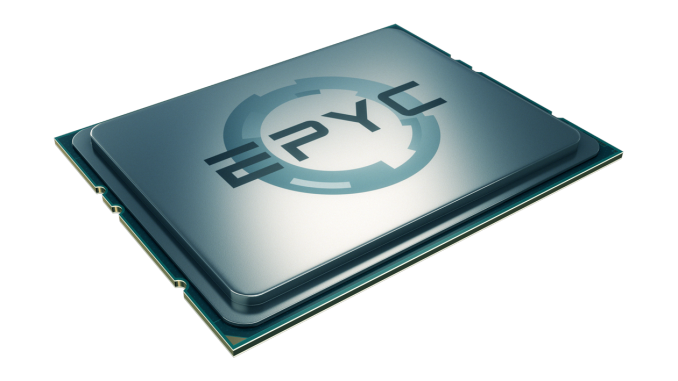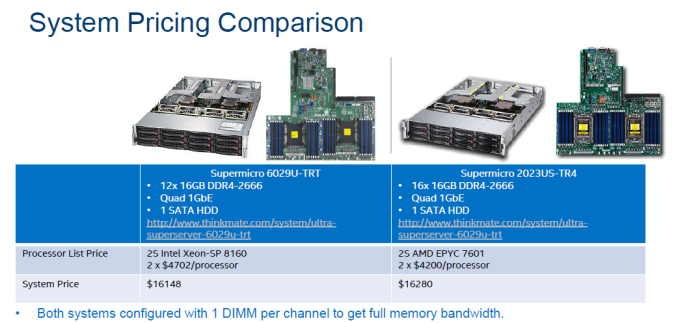Dissecting Intel's EPYC Benchmarks: Performance Through the Lens of Competitive Analysis
by Johan De Gelas & Ian Cutress on November 28, 2017 9:00 AM EST- Posted in
- CPUs
- AMD
- Intel
- Xeon
- Skylake-SP
- Xeon Platinum
- EPYC
- EPYC 7601

Although the AMD EPYC is definitely a worthy contender in the server space, AMD's technical marketing of the new CPU has been surprisingly absent, as the company not published any real server benchmarks. The only benchmarks published were SPEC CPU and Stream, with AMD preferring for its partners and third parties to promote performance. And, as our long-time readers know, while the SPEC CPU benchmarks have their merits and many people value them, they are a very poor proxy of most server workloads.
In every launch, we expect companies to offer an element of competitive analysis, often to show how their platform is good or better than the rest. At the launch of Intel's latest Xeon-SP platform, analysis to EPYC was limited to a high-level, as the systems were not as freely available as expected. AMD was able to do so on Broadwell-E at the time of the EPYC announcement because it was out and available - Intel wasn't able to do it on EPYC because AMD were several months away from moving it from a cloud-only ramp up program. This is partly the effect of AMD's server market implementation and announcement roadmap, although it didn't stop Intel from hypothesising about the performance deficits in ways that caught the attention of a number of online media.
Throughout all of this, AMD could not resist but to continue to tell the world that the "EPYC SoC Sets World Records on SPEC CPU Benchmarks". In the highly profitable field that is server hardware, this could not be left unanswered by Intel, who responded that the Intel Xeon Scalable has great "momentum" with no less than 110 performance records to date.
Jumping to the present time, in order to to prove Xeon-SP dominance over the competition, Intel's data center engineering group has been able to obtain a few EPYC systems and has started benchmarking. This benchmarking, along with justifications of third-party verification, was distributed to the small set of Xeon-SP launch reviewers as a guide, to follow up on that high-level discussion some time ago. The Intel benchmarking document we received had a good amount of detail however, and the conference call we had relating to it was filled with some good technical tidbits.
Our own benchmarks showed that the EPYC was a very attractive alternative in some workloads (Java applications), while the superior mesh architecture makes Intel's Xeon the best choice in other (Databases for example).
A Side Note About SPEC
A number of these records were achieved through SPEC. As mentioned above, while SPEC is a handy tool for comparing the absolute best tweaked peak performance of the hardware underneath, or if the system wants to be analysed close to the metal because of how well known the code base is, but this has trouble transferring exactly to the real world. A lot of time the software within a system will only vaguely know what system it is being run on, especially if that system is virtualised. Sending AVX-512 commands down the pipe is one thing, but SPEC compilation can be tweaked to make sure that cache locality is maintained whereas in the real-world, that might not be possible. SPEC says a lot about the system, but ultimately most buyers of these high-end systems are probing real-world workloads on development kits to see what their performance (and subsequent scale-out performance) might be.
For the purposes of this discussion, we have glossed over Intel's reported (and verified over at SPEC.org) results.
Pricing Up A System For Comparison
Professionals and the enterprise market will mention, and quite rightly, that Intel has been charging some heavy premiums with the latest generation, with some analysts mentioning a multiple jump up in pricing even for large customers, making it clear that the Xeon enterprise CPU line is their bread and butter. Although Intel's top-end Xeon Platinum 8180 should give the latest EPYC CPU a fit of trouble thanks to its 28 Skylake-SP cores running at 2.5 to 3.8 GHz, the massive price tag ($10009 for the standard version, $13011 for the high-memory model) made sure that Intel's benchmarking team had no other choice than also throwing in a much more modest Xeon Platinum 8160 (24 cores at 2.1 - 3.7 GHz, $4702k) as well as the Xeon Gold 6148 (20 cores at 2.4-3.7 GHz, $3072).
| SKUS Tested | |||||
| Intel Xeon Platinum 8180 |
Intel Xeon Platinum 8160 |
Intel Xeon Gold 6148 |
AMD EPYC 7601 |
||
| Release Date | Early Q3, 2017 | Late Q2, 2017* | |||
| Microarchitecture | Skylake-SP with AVX-512 | Zen | |||
| Process Node | Intel 14nm (14+) | GloFo 14nm | |||
| Cores / Threads | 28 / 56 | 24 / 48 | 20 / 40 | 32 / 64 | |
| Base Frequency | 2.5 GHz | 2.1 GHz | 2.4 GHz | 2.2 GHz | |
| Turbo | 3.8 GHz | 3.7 GHz | 3.7 GHz | 3.2 GHz | |
| L2 Cache | 28 MB | 24 MB | 20 MB | 16 MB | |
| L3 Cache | 38.5 MB | 33.0 MB | 27.5 MB | 64 MB | |
| TDP | 205 W | 150 W | 150 W | 180 W | |
| PCIe Lanes | 48 (Technically 64 w/ Omni-Path Versions) | 128 | |||
| DRAM | 6-channel DDR4 | 8ch DDR4 | |||
| Max Memory | 768 GB | 2048 GB | |||
| Price | $10009 | $4702 | $3072 | $4200 | |
As a result of this pricing, one of the major humps for Intel in any comparison will be performance per dollar. In order to demonstrate that systems can be equivalent, Intel offered up this comparison from a single retailer. Ideally Intel should have offered multiple configurations options for this comparison, given that a single retailer can intend for different margins on different sets of products (or have different levels of partnership/ecosystem with the manufacturers).
Even then, price parity could only be reached by giving the Intel system less DRAM. Luckily this was the best way to configure the Intel based system anyway. We can only guess how much the benchmarking engineers swore at the people who set the price tags: "this could have been so much easier...". All joking apart, the document we received had a good amount of detail, and similar to how we looked into AMD's benchmarking numbers at their launch, we investigated Intel's newest benchmark numbers as well.











105 Comments
View All Comments
hsupengjun - Sunday, December 3, 2017 - link
Wow, the first few pages are sooo biased, but damn, are they rightfully so.ajc9988 - Tuesday, January 16, 2018 - link
@Ian Cutress & Johan De Gelas - Could you please update this by running your own numbers AFTER the full implementation of Spectre and Meltdown fixes. That would be so helpful in showing how much these have effected both platforms and whether your conclusions remain after the fixes. Thank you!FentonW - Wednesday, January 17, 2018 - link
What this doesn't really address is Memory configurations.RAM configurations are very much limited with intel given the 2 DIMMS per channel configuration and 6 channels vs 8 with AMD.
With Intel you can only get 384GB with 16GB DIMMS, compared to 512GB with AMD.
If you need 512GB then you have to use 32GB DIMMS on intel which again pushes the price up considerably.
Which is why customers often choose a Broadwell system over Skylake, to keep memory costs down.
Justinodomi - Thursday, August 20, 2020 - link
Зарабатывай до 47000 рублей в месяц https://bit.ly/3k71xT0Помощь в оформлении мед. книжки
https://clck.ru/QH2ia
Georgeyqp - Wednesday, September 9, 2020 - link
https://bit.ly/31vZZtsРаньше пользователи CryptoTab PRO могли ускорять майнинг токмо быть помощи функции Cloud.Boost. Мы решили начинать дальше и предоставить вам доступ к новейшей опции Super.Boost, чтобы вы зарабатывали больше — и быстрее! Оцените преимущества сверхскоростного майнинга с расширением Super.Boost, доступным в PRO-версии Android приложения.
Используйте разом порядочно ускорений Super.Boost и увеличьте общую прыть майнинга для всех ваших устройствах с включеннойй функцией Cloud.Boost. https://bit.ly/33KzbIO
Скажем, проворство вашего устройства — 100H/s, с Cloud.Boost X10 живость составит уже 1000H/s. А с двумя дополнительными ускорениями Super.Boost +80% и +60% суммарная скорость майнинга будет равна 2400H/s (1000H/s + 1000H/s*0,8 + 1000H/s*0.6 = 1000 + 800 + 600).
Скачай CryptoTab PRO и открой ради себя сверхбыстрый майнинг! https://clck.ru/QAzh8
Устанавливая PRO-версию Android-приложения помимо опции Super.Boost, вы также получите расширенный ассортимент функций:
Cloud Expel — часто ускоренный майнинг
Занятие SDP: сервер-зависимый майнинг не тратит заряд батареи
Быстрый доступ к кабинету ради хранения и вывода криптовалюты
Неограниченное число подключённых удалённых устройств
Обновление баланса некогда в 10 минут
Неограниченный нравоучение средств от 0.00001 BTC
Отдельные профили чтобы разных пользователей
Защищенный профиль для публичного Wi-Fi
Приоритетная техническая поддержка
Адаптивная новостная лента
Никакой надоедливой рекламы
Специальные промо-материалы и распродажи
Майнинг на мобильных устройствах снова сроду не был таким быстрым! Скачай Android-приложение, включи Cloud.Boost и открой для себя суперскоростной майнинг с функцией Super.Boost.
Перейти сообразно ссылке: https://clck.ru/QAzyL
@Crypto_Good